fastlane is now part of Fabric
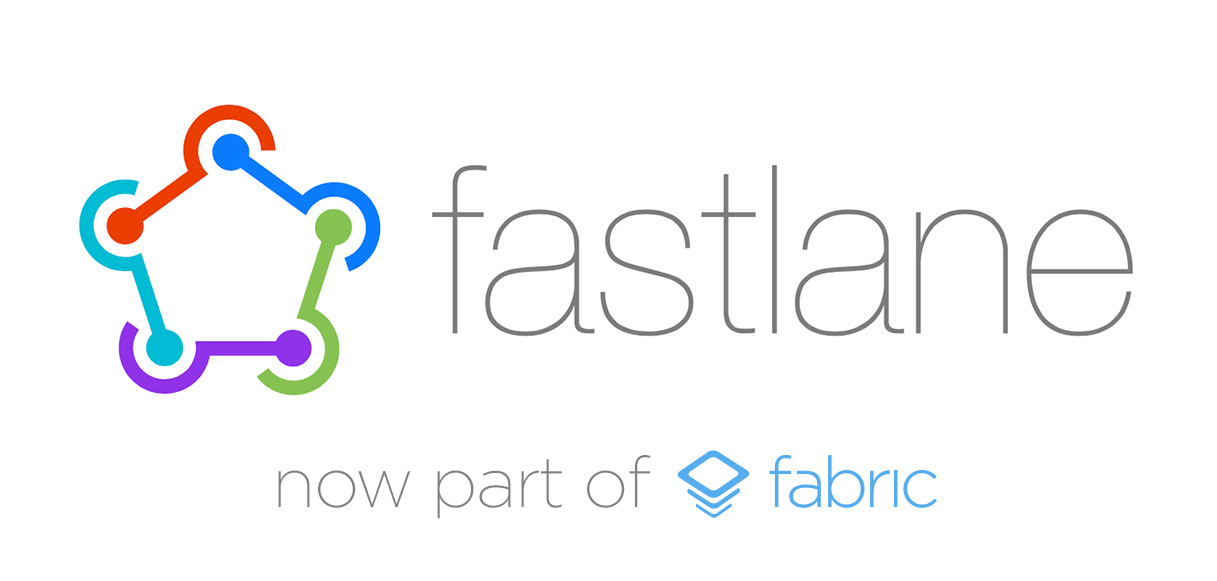
Update 2017: fastlane got acquired by Google
I started fastlane as a side project about a year ago. In just a short time, fastlane became the most popular iOS automation toolset, used by thousands of developers around the world. I never imagined that so many people would use it or how much time it would require to maintain it. It became a full time job!
That’s why today, I’m happy to announce that fastlane is now part of Fabric, where I will get to focus on fastlane full time and work on building the best developer tools available.
What the future holds
fastlane will stay an open source project, and I will continue to work on new features.The Fabric team is committed helping fastlane grow for both existing fastlane users and new ones.
And for the last two months, while I’ve been working from Twitter HQ in San Francisco, I was able to prepare a few big things:
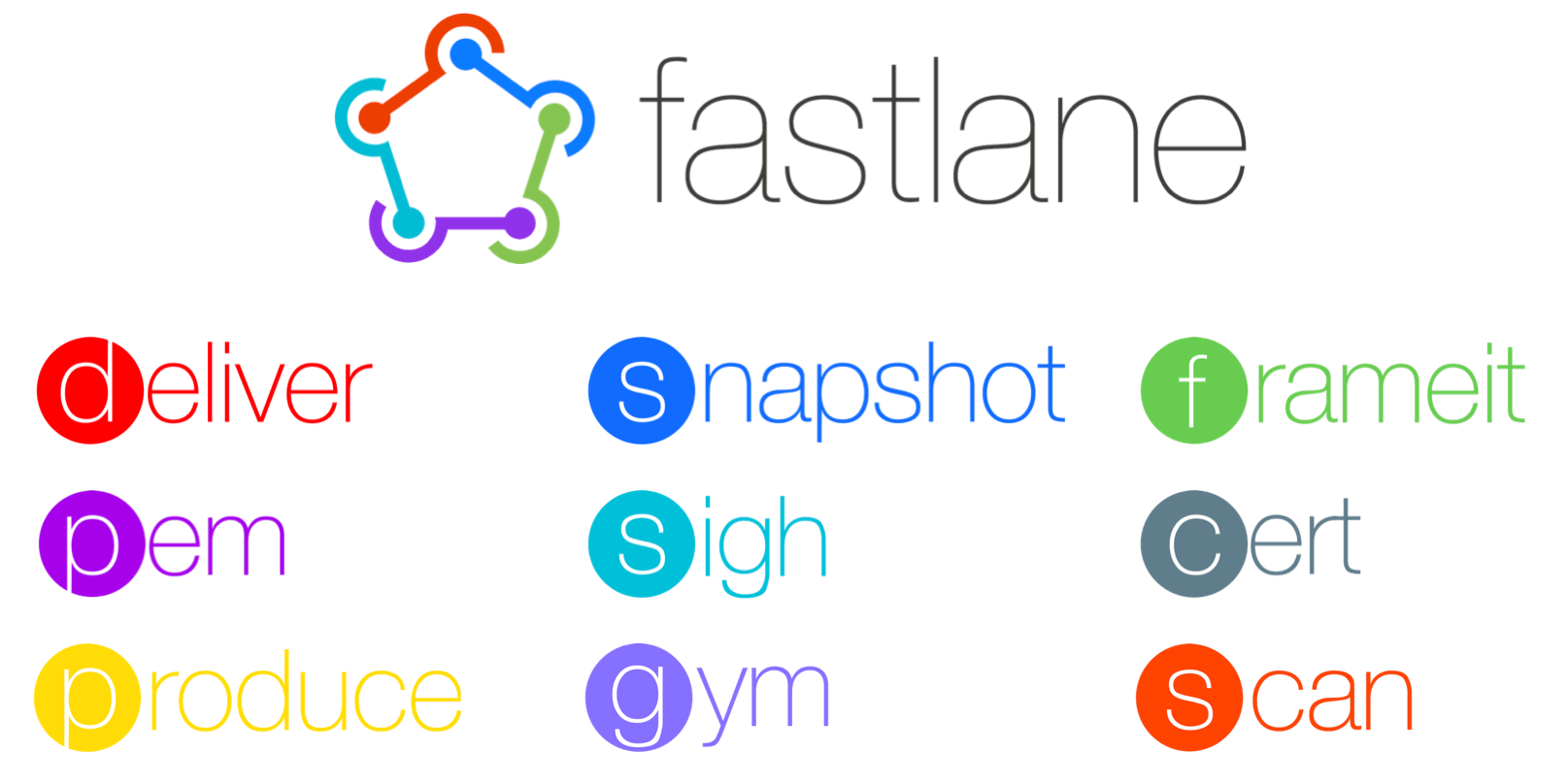
1.0 Releases for all tools
In the last few weeks, I’ve been focusing a lot on quality. All fastlane tools now use spaceship to communicate with Apple. I’m very excited that all fastlane tools are now available as 1.0 releases, and I’m really looking forward to the things we’re building next.
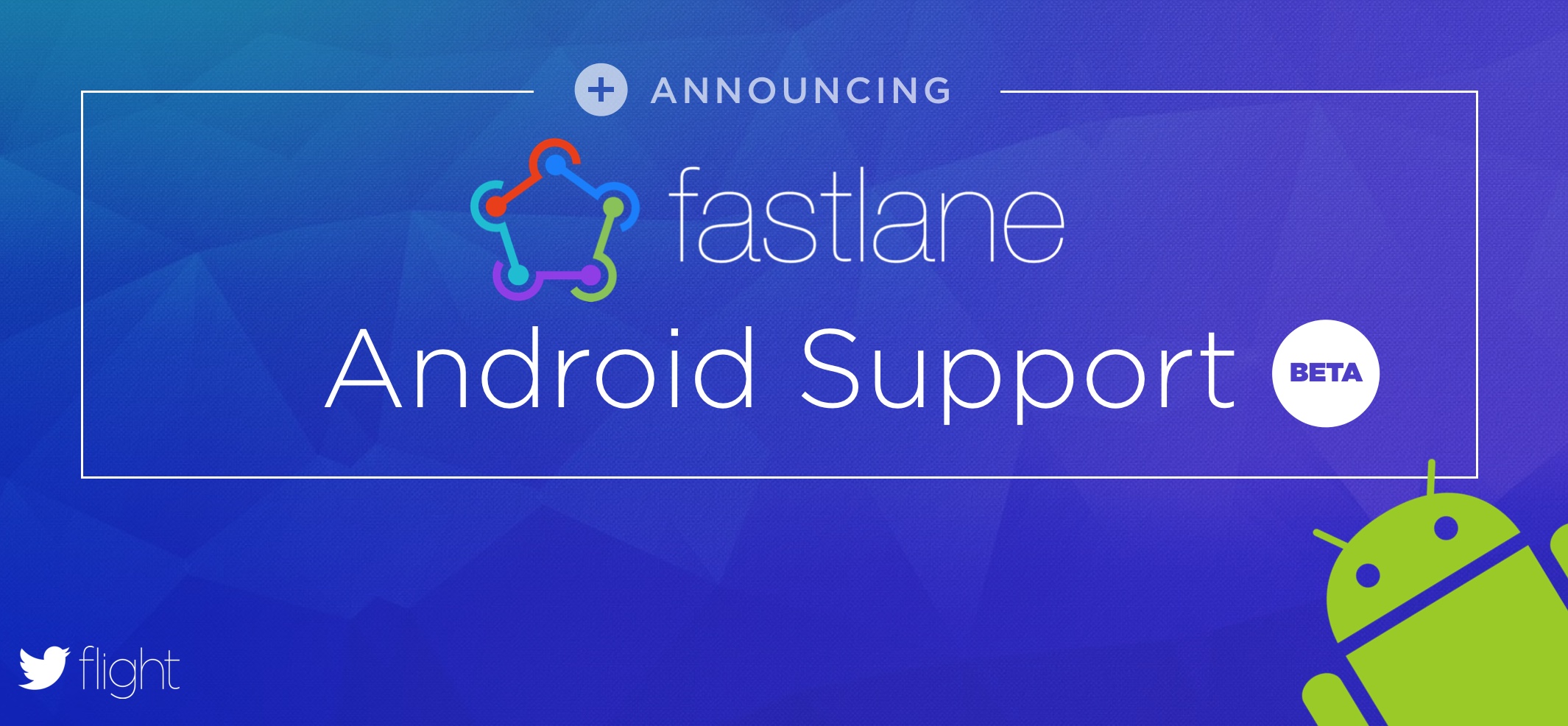
fastlane for Android (Beta)
fastlane is the most popular Continuous Delivery solution for iOS apps. But I always wanted to make fastlane a tool that both iOS and Android developer could benefit from.
As of today, you can use fastlane for both your iOS and Android projects.Get started with fastlane for Android!

snapshot now uses UI Tests
Earlier this year Apple announced Xcode 7 with support for UI Tests. This technology allows snapshot to be even better: Instead of using UI Automation Javascript code, you can now write the screenshot code in Swift or Objective C allowing you to use the powerful debugging features built into Xcode.
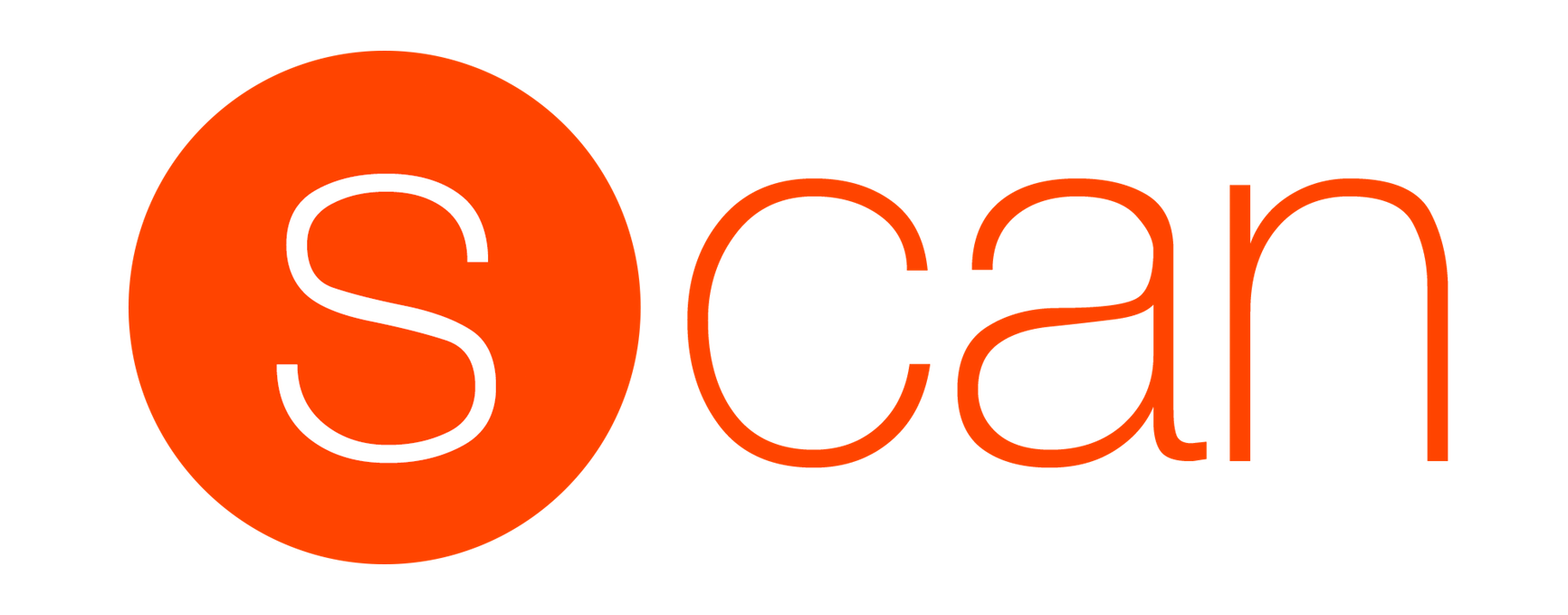
New tool: scan
A lot of developers use fastlane to run tests on their project. Up until now, fastlane used third party test runners to run and monitor tests. As of today, there is a new tool called scan,making it super simple to run the tests of your iOS and Mac application.
If you’re an existing fastlane user, you can be excited about the next few weeks and what I have in the pipeline. If you’re new to fastlane, now is the best time to get started
Update 2017: fastlane got acquired by Google
Thoughts on iOS build tools
Up until now you had 2 good ways to build and sign your application from the command line:
- Use the built-in
xcodebuildcommand - Use the third party tool shenzhen
Both approaches have their problems
xcodebuild
When using xcodebuild you have to fiddle around with a long list of available parameters:
xcodebuild clean archive -archivePath build/MyApp \
-scheme MyApp
xcodebuild -exportArchive \
-exportFormat ipa \
-archivePath "build/MyApp.xcarchive" \
-exportPath "build/MyApp.ipa" \
-exportProvisioningProfile "ProvisioningProfileName"
That’s not something you remember and just enter every time you want to build an ipa file. The command above will generate a huge amount terminal output (talking > 10MB). For every source file that gets complied xcodebuild prints out around 60 lines of information you don’t really care about:
rause/Library/Developer/Xcode/DerivedData/Example-fhlmxikmujknefgidqwqvtbatohi/Build/Intermediates/ArchiveIntermediates/Example/IntermediateBuildFilesPath/Example.build/Release-iphoneos/Example.build/Objects-normal/arm64/main.o Example/main.m normal arm64 objective-c com.apple.compilers.llvm.clang.1_0.compiler
cd /Users/felixkrause/Developer/fastlane/gym/example/cocoapods
export LANG=en_US.US-ASCII
export PATH="/Applications/Xcode-beta.app/Contents/Developer/Platforms/iPhoneOS.platform/Developer/usr/bin:/Applications/Xcode-beta.app/Contents/Developer/usr/bin:/Users/felixkrause/.rvm/gems/ruby-2.2.0/bin:/Users/felixkrause/.rvm/gems/ruby-2.2.0@global/bin:/Users/felixkrause/.rvm/rubies/ruby-2.2.0/bin:/Users/felixkrause/.rvm/bin:/usr/local/heroku/bin:/usr/local/bin:/usr/bin:/bin:/usr/sbin:/sbin"
/Applications/Xcode-beta.app/Contents/Developer/Toolchains/XcodeDefault.xctoolchain/usr/bin/clang -x objective-c -arch arm64 -fmessage-length=126 -fdiagnostics-show-note-include-stack -fmacro-backtrace-limit=0 -fcolor-diagnostics -std=gnu99 -fobjc-arc -fmodules -gmodules -fmodules-cache-path=/Users/felixkrause/Library/Developer/Xcode/DerivedData/ModuleCache -fmodules-prune-interval=86400 -fmodules-prune-after=345600 -fbuild-session-file=/Users/felixkrause/Library/Developer/Xcode/DerivedData/ModuleCache/Session.modulevalidation -fmodules-validate-once-per-build-session -Wnon-modular-include-in-framework-module -Werror=non-modular-include-in-framework-module -Wno-trigraphs -fpascal-strings -Os -fno-common -Wno-missing-field-initializers -Wno-missing-prototypes -Werror=return-type -Wunreachable-code -Wno-implicit-atomic-properties -Werror=deprecated-objc-isa-usage -Werror=objc-root-class -Wno-arc-repeated-use-of-weak -Wduplicate-method-match -Wno-missing-braces -Wparentheses -Wswitch -Wunused-function -Wno-unused-label -Wno-unused-parameter -Wunused-variable -Wunused-value -Wempty-body -Wconditional-uninitialized -Wno-unknown-pragmas -Wno-shadow -Wno-four-char-constants -Wno-conversion -Wconstant-conversion -Wint-conversion -Wbool-conversion -Wenum-conversion -Wshorten-64-to-32 -Wpointer-sign -Wno-newline-eof -Wno-selector -Wno-strict-selector-match -Wundeclared-selector -Wno-deprecated-implementations -DCOCOAPODS=1 -DNS_BLOCK_ASSERTIONS=1 -DOBJC_OLD_DISPATCH_PROTOTYPES=0 -isysroot /Applications/Xcode-beta.app/Contents/Developer/Platforms/iPhoneOS.platform/Developer/SDKs/iPhoneOS9.0.sdk -fstrict-aliasing -Wprotocol -Wdeprecated-declarations -miphoneos-version-min=9.0 -g -fvisibility=hidden -Wno-sign-conversion -fembed-bitcode -iquote /Users/felixkrause/Library/Developer/Xcode/DerivedData/Example-fhlmxikmujknefgidqwqvtbatohi/Build/Intermediates/ArchiveIntermediates/Example/IntermediateBuildFilesPath/Example.build/Release-iphoneos/Example.build/ExampleProductName-generated-files.hmap -I/Users/felixkrause/Library/Developer/Xcode/DerivedData/Example-fhlmxikmujknefgidqwqvtbatohi/Build/Intermediates/ArchiveIntermediates/Example/IntermediateBuildFilesPath/Example.build/Release-iphoneos/Example.build/ExampleProductName-own-target-headers.hmap -I/Users/felixkrause/Library/Developer/Xcode/DerivedData/Example-fhlmxikmujknefgidqwqvtbatohi/Build/Intermediates/ArchiveIntermediates/Example/IntermediateBuildFilesPath/Example.build/Release-iphoneos/Example.build/ExampleProductName-all-target-headers.hmap -iquote /Users/felixkrause/Library/Developer/Xcode/DerivedData/Example-fhlmxikmujknefgidqwqvtbatohi/Build/Intermediates/ArchiveIntermediates/Example/IntermediateBuildFilesPath/Example.build/Release-iphoneos/Example.build/ExampleProductName-project-headers.hmap -I/Users/felixkrause/Library/Developer/Xcode/DerivedData/Example-fhlmxikmujknefgidqwqvtbatohi/Build/Intermediates/ArchiveIntermediates/Example/BuildProductsPath/Release-iphoneos/include -I/Users/felixkrause/Developer/fastlane/gym/example/cocoapods/Pods/Headers/Public -I/Users/felixkrause/Developer/fastlane/gym/example/cocoapods/Pods/Headers/Public/HexColors -I/Users/felixkrause/Library/Developer/Xcode/DerivedData/Example-fhlmxikmujknefgidqwqvtbatohi/Build/Intermediates/ArchiveIntermediates/Example/IntermediateBuildFilesPath/Example.build/Release-iphoneos/Example.build/DerivedSources/arm64 -I/Users/felixkrause/Library/Developer/Xcode/DerivedData/Example-fhlmxikmujknefgidqwqvtbatohi/Build/Intermediates/ArchiveIntermediates/Example/IntermediateBuildFilesPath/Example.build/Release-iphoneos/Example.build/DerivedSources -F/Users/felixkrause/Library/Developer/Xcode/DerivedData/Example-fhlmxikmujknefgidqwqvtbatohi/Build/Intermediates/ArchiveIntermediates/Example/BuildProductsPath/Release-iphoneos -isystem /Users/felixkrause/Developer/fastlane/gym/example/cocoapods/Pods/Headers/Public -isystem /Users/felixkrause/Developer/fastlane/gym/example/cocoapods/Pods/Headers/Public/HexColors -MMD -MT dependencies -MF /Users/felixkrause/Library/Developer/Xcode/DerivedData/Example-fhlmxikmujknefgidqwqvtbatohi/Build/Intermediates/ArchiveIntermediates/Example/IntermediateBuildFilesPath/Example.build/Release-iphoneos/Example.build/Objects-normal/arm64/main.d --serialize-diagnostics /Users/felixkrause/Library/Developer/Xcode/DerivedData/Example-fhlmxikmujknefgidqwqvtbatohi/Build/Intermediates/ArchiveIntermediates/Example/IntermediateBuildFilesPath/Example.build/Release-iphoneos/Example.build/Objects-normal/arm64/main.dia -c /Users/felixkrause/Developer/fastlane/gym/example/cocoapods/Example/main.m -o /Users/felixkrause/Library/Developer/Xcode/DerivedData/Example-fhlmxikmujknefgidqwqvtbatohi/Build/Intermediates/ArchiveIntermediates/Example/IntermediateBuildFilesPath/Example.build/Release-iphoneos/Example.build/Objects-normal/arm64/main.o
The best way to fix the output annoyance is to use xcpretty in which you can pipe the xcodebuild ouput.
shenzhen
shenzhen was the easiest way to build your iOS application: It took care of generating the xcodebuild commands to build your application. But instead of showing a clean output while building, it omitted the complete output of the whole process.
The main issue with shenzhen was the information you received when you run into an error:
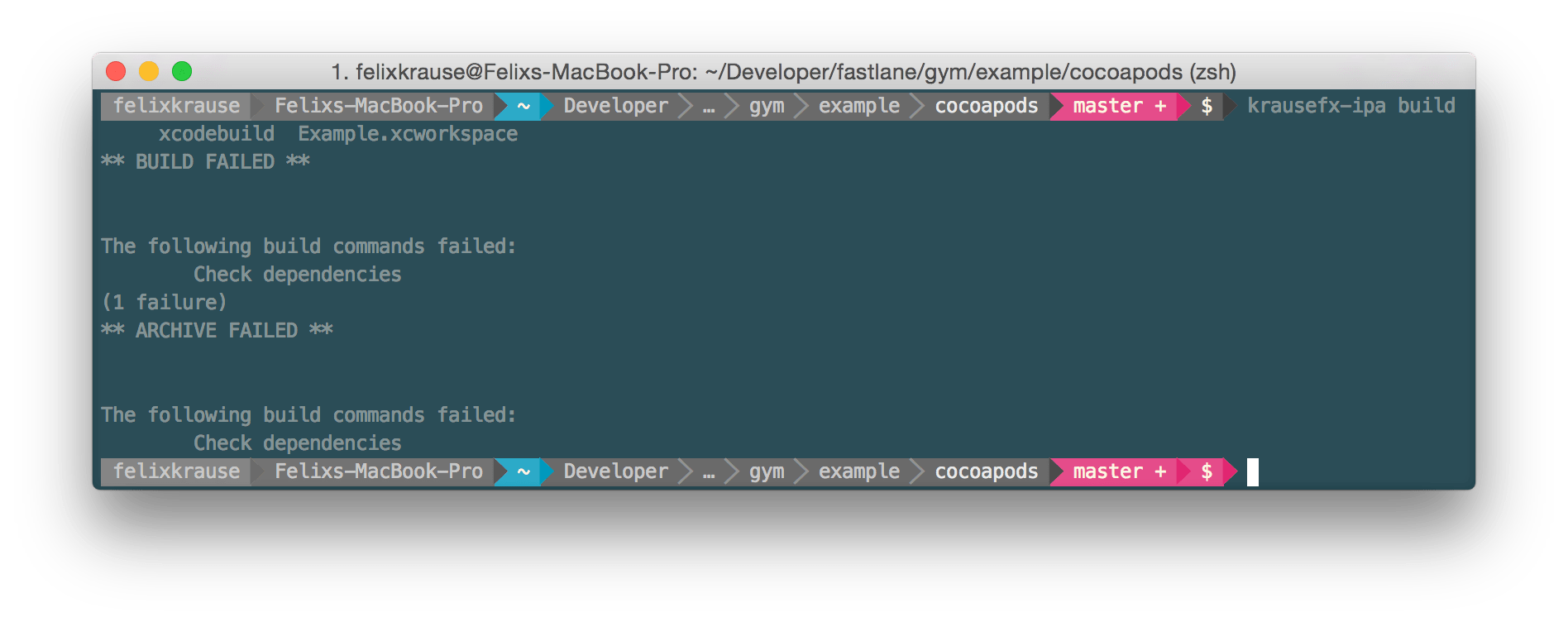
You know what you’d need to do to solve this issue? No, it’s not clear, you don’t get any information that helps you fix this issue. That’s a simple code signing issue, in which the project defines a provisioning profiles that doesn’t exist.
shenzhen is a great tool, but hasn’t received any updates recently. With fastlane I used a fork of shenzhen to fix some bugs. After a time I decided to build ‘gym’, a tool which should replace the building part of shenzhen.(shenzhen also does distribution to beta testing services)
Improving the process
In my opinion it’s really important a tool does different things depending on the outcome:
- When the tool succeeded, the user doesn’t need a lot of output/information, except that everything worked fine
- When something went wrong while building, the user should get as much relevant information as possible to make it easy to quickly fix the issue.

Tools should actively help the user resolve common issues. By showing as much useful information as possible and even telling the user how to fix it, a tool automatically becomes much more useful.
Tools can automatically detect all kinds of issues and help the user fix them really fast:

When gym succeeds the terminal output is minimalistic but still shows relevant and useful information while processing
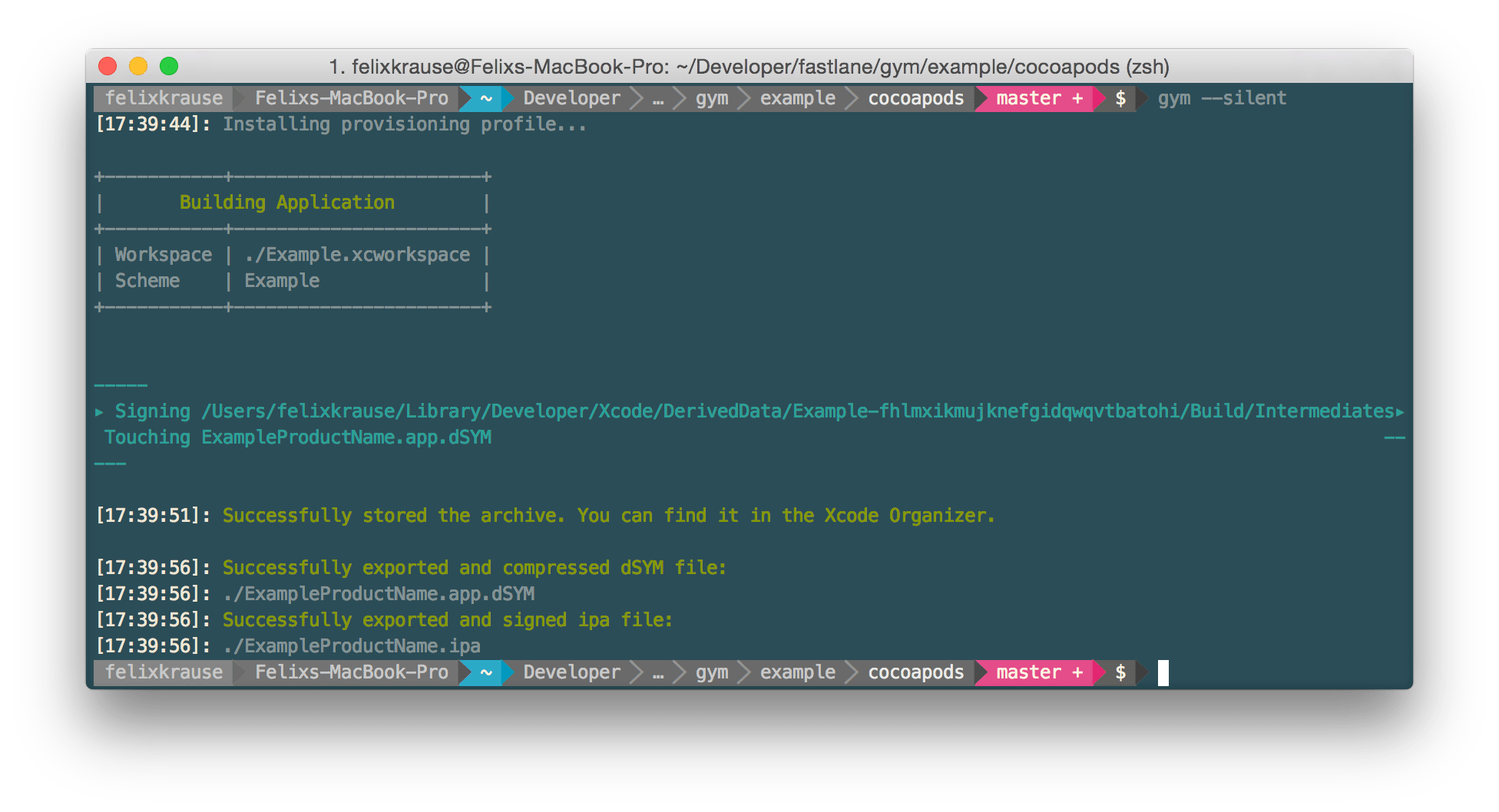
Another important point is being compatible with existing technologies. With gym for example I want the user to still be able to use the Xcode Organiser to distribute the archive or dSYM file

Information
When writing about developer tools I don’t want to forget the famous “Fix Issue” button.

How can we improve it?
The most important things a developer tool should do
- Expose information about what Xcode is going to try when you click “Fix Issue”
- Show a log of what was tried and what failed
- If possible show the user how to fix an issue manually
In the example of gym you get every shell command that is being executed printed out so you can manually try fixing something in case the build process fails.
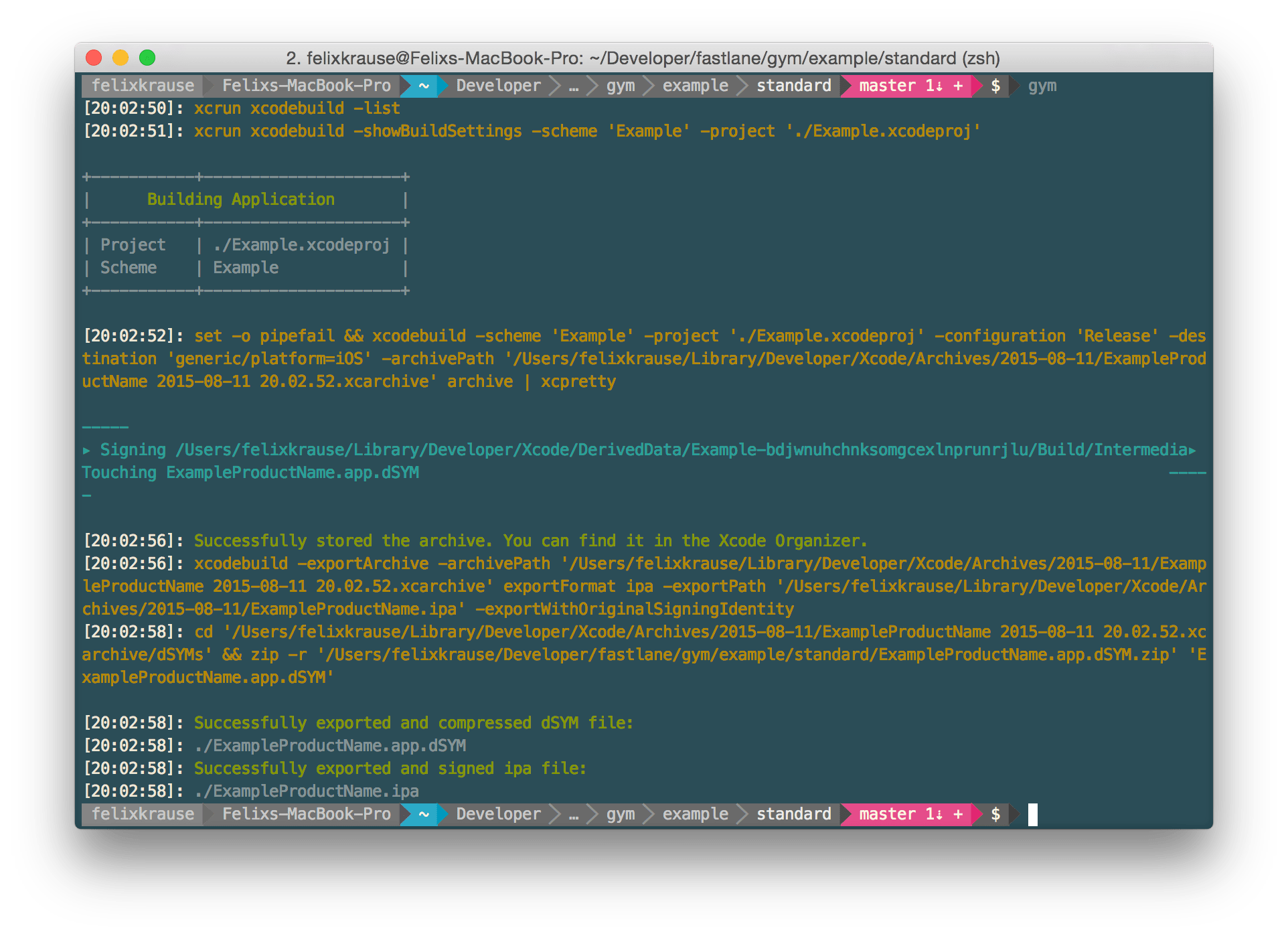
If you need even more information, the you can use --verbose flag.
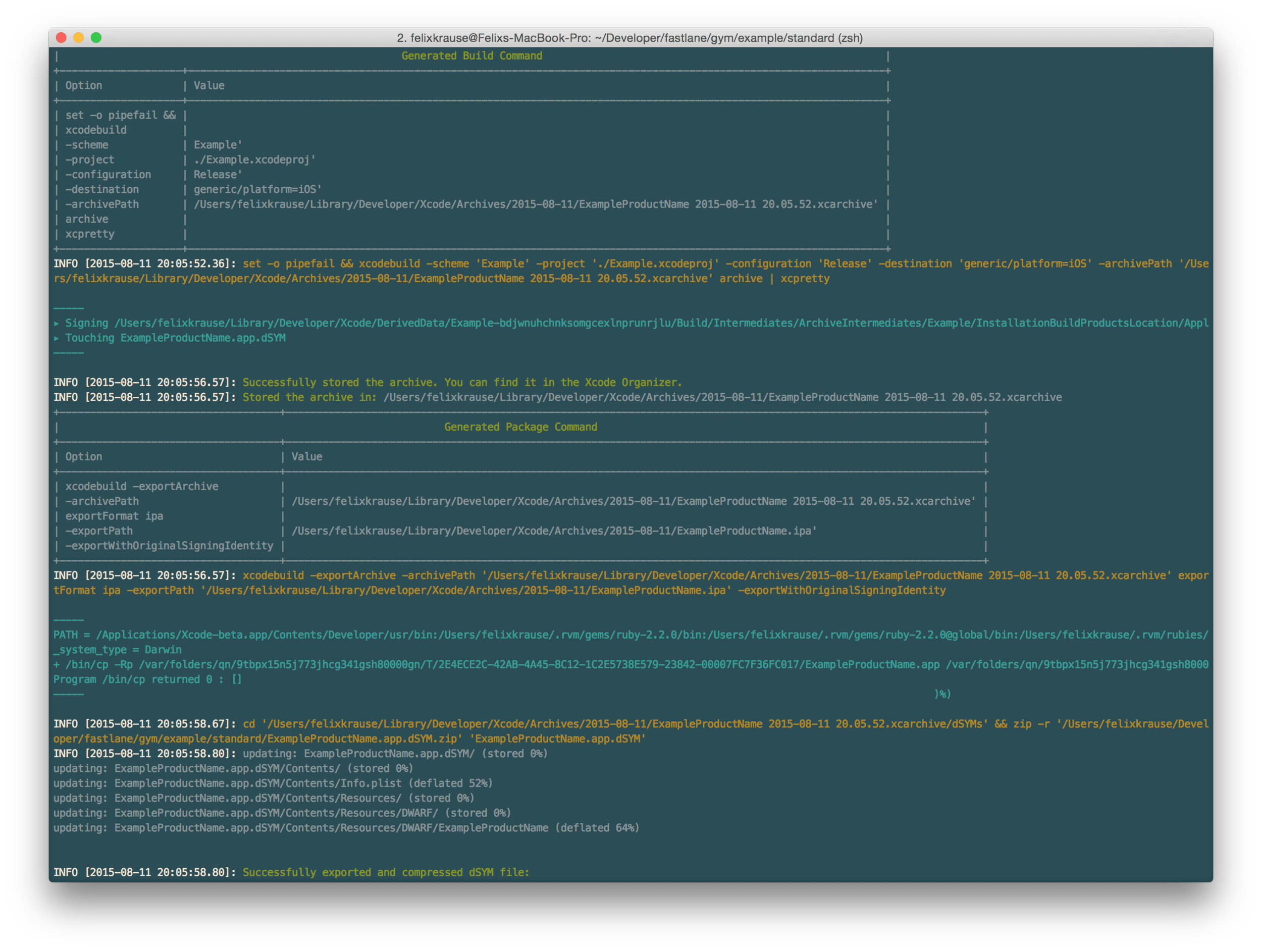
Conclusion
Besides standard features like sensible defaults and convention over configuration, I think it’s important the user knows what’s going on with the tool. This allows the users to debug issues themselves. By being transparent you build up trust. Developer see what the tool is doing.
You can check out gym on GitHub: https://github.com/fastlane/gym
spaceship - now also supporting iTunes Connect
It’s been about 6 weeks since the initial version of spaceship was released. As you may know, spaceship is the tool that’s powering almost all of the other fastlane tools to interact with Apple’s web-services.
Just 10 days ago I silently rolled out the initial version of spaceship for iTunes Connect to use it in the new tools you all have been using already: pilot and boarding.
I finished implementing all remaining API endpoints and writing the documentation to finally release this:
Introducing the first version of spaceship for iTunes Connect
Finally you can interact with all important API endpoints the iTunes Connect service has to offer without using the iTunes Connect front-end. All API calls are really fast as spaceshipcommunicates with the WebObject based back-end directly.
Here are some examples taken from the official documentation:
# Fetch all available applications
all_apps = Spaceship::Tunes::Application.all
# Find a specific app based on the bundle identifier or Apple ID
app = Spaceship::Tunes::Application.find("com.krausefx.app")
# or
app = Spaceship::Tunes::Application.find(794902327)
# Access information about the app
app.apple_id # => 1013943394
app.name # => "Spaceship App"
app.bundle_id # => "com.krausefx.app"
# Show the names of all your apps
Spaceship::Tunes::Application.all.collect do |app|
app.name
end
# Create a new app
app = Spaceship::Tunes::Application.create!(name: "App Name",
primary_language: "English",
version: "1.0",
sku: 123,
bundle_id: "com.krausefx.app")
# Submitting an app for review
submission = app.create_submission
# Set app submission information
submission.content_rights_contains_third_party_content = true
submission.content_rights_has_rights = true
submission.add_id_info_uses_idfa = false
# Finalize app submission
submission.complete!
For more examples check out the official documentation on GitHub.
What can you do with spaceship for iTunes Connect?
- Manage your applications, update their metadata and even submit apps for review
- Manage your app’s builds and get information like the testing status, number of installs, expiry date and even submit builds for TestFlight beta review
- Manage all your beta testers (check out pilot and boarding as an example project using it)
What could you build with spaceship for iTunes Connect?
- Automatically sync iTunes Connect users with your company internal user system
- Automatic daily backups of all iTunes Connect and Apple Dev Portal data
- Automatically send customers emails once a new version of their app got approved
- Build a lightweight dashboard for your clients to see a grid of their apps with the current download numbers, reviews and app review status
- Add App Review Notifications (e.g. Waiting for Review) to your company dashboard or push them directly to Slack
A gif showing deliver downloading all existing screenshots from iTunes Connect using spaceship
Letting computers do the hard work

As iOS developers we’re still used to doing many manual tasks. It’s an issue that exists because everything is still new. Just ask your back-end developer about the last time they manually deployed a new version directly to the production server. The answer should be: Oh, I was still in high school back then. Why? Because there are many mechanisms before the actual release to avoid broken releases that don’t pass the tests.
Using fastlane you can already automate a large part of your daily development tasks, but one thing was missing:
Have you ever been to an airport, where you had to ask the manager of the airport if you can board now? Once the manager agrees, you’ll be carried from your check-in to your gate into your plane.
Because that’s what you are doing right now as an app developer when you want to invite a beta tester to your TestFlight app. And you even repeat that for every single beta tester you invite.
Right now, you have to go through 9 steps (on the right) just to invite one beta tester to your TestFlight program.
Have you ever asked a blog publisher if they add you to their newsletter? No, that’s not how that works!
I just launched boarding, a tool that allows you to launch your own TestFlight Invite page in under 3 minutes.
More information about this project can be found on GitHub.
About Automation
If you’re reading this post, chances are high you are an iOS/Mac developer. You get paid for developing iOS applications which is probably what you’re best in.
Are you responsible for…?
- Creating and uploading screenshots
- Updating app metadata like the description
- Manually building and uploading a beta build when your boss tells you to
- Inviting new beta testers to your beta testing service
You probably said yes to some of those points. In my experience most developers do those things manually. Why?
We haven’t got time to automate this stuff, because we’re too busy dealing with the problems caused by our lack of automation. - @bitfield
While some developer may enjoy doing passive activities, you usually want to get your job done. That means working on the iOS/Mac app itself working on awesome new features.
That’s why we have to follow our friends from the back-end team and start automating tedious processes. Instead of us, computer should do those tasks.

As you can see, the users interested in beta testing your application accesses your Heroku application directly to enter their email address. The Heroku app will then use spaceship to communicate with iTunes Connect directly without any interaction from a real person. Spaceship automatically registers the new testers, adds them to the application and sends out the TestFlight email.
You as an developer are in no way involved in this process. Once you merge into your beta branch, fastlane will go ahead and build, sign and upload your app, resulting in automatic emails to all your testers. (this depends on how you use fastlane)
If you tried the Heroku button, you’ll see there are no additional manual steps required to get a web service running. You enter your credentials, choose your application and the web service is up and running.
What’s next?
The primary use case of boarding was not to actually solve this certain problem, but to demonstrate what’s possible using spaceship. In only 24 hours I had the idea for boarding, started working on it and released it publicly.
Think about what you can build with spaceship. It’s a foundational tool to communicate with Apple’s web services, both the Apple Developer Portal and iTunes Connect allowing you to build all kinds of cool things!
Some random ideas:
- Automatically sync iTunes Connect users with your company internal user system
- Automatic daily backups of all iTunes Connect and Apple Dev Portal data
- Automatically send customers emails once a new version of their app got approved
- Build a lightweight dashboard for your clients to see a grid of their apps with the current download numbers, reviews and app review status
- Using the same change-log text for all languages? Why should you copy&paste the text manually to 10 languages?
- Added App Review information to your company dashboard or push them directly to Slack
Tags: testflight, automation, spaceship, boarding | Edit on GitHub

